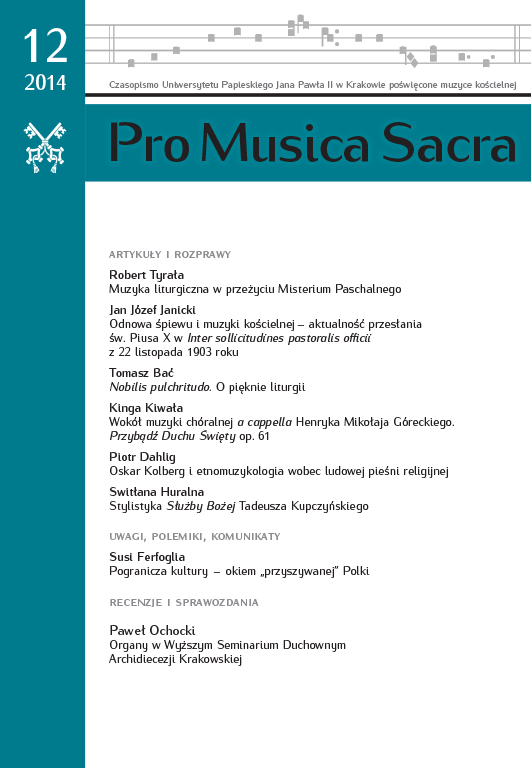The Revival of Church Singing and Music – modern relevance of St. Pius X’s message of Inter sollicitudines pastoralis officii of 22 November 1903
DOI:
https://doi.org/10.15633/pms.1512Keywords:
St. Pius X, singing in liturgy, sacred music, Gregorian chant, singing and secular music in liturgy, improper sacred musicAbstract
Amongst many activities aimed at the revival of Christian life, undertaken by the Church in 19th and at the beginning of the 20th centuries, it was the revival of liturgy which started to enrich her religious life. The very essence of Christian life was re-seen in liturgy and it was in liturgy that the means of the revival were sought; “not only by new means of influence’, but also through giving the Church life “a sense of so desirable respectability and dignity”.
The first and most authoritative person, indicating the liturgy as a font of spiritual life for every Christian, not only for „chosen” few groups of the faithful, was Pope Pius X, “the Shepherd of the souls” who made his motto: Instaurare omnia in Christo the programme of his service. So as to realize this programme of “restoring all things in Christ” in the realm of liturgy he focused all his efforts first of all on the revival of singing and liturgical music (motu proprio Inter sollicitudines pastoralis officii – Tra le sollicitudini). This document was published on 22 November 1903 on liturgical feast of St. Cecilia, the virgin and the martyr, and the patroness of sacred music. The Saint Congregation of Rites, by their decree of 8 January 1904, promulgated the above pontifical document as “a juridical code of sacred music”
In his motu proprio of 22 November 1903, published in the form of instructions on sacred music ((Instructio de musica sacra), Pope Pius X successfully restored the Gregorian chant, according to the ancient books, re-introducing it to their primary use in churches, and collecting all prescripts into a whole. Their aim was to build up or restore the sanctity and solemnity of church singing, and by the power of the authority of the Holy See, making this collection a juridical, lawfully abiding code.
Ojciec święty Pius X zaraz na początku swego pontyfikatu skierował do całego Kościoła powszechnego stosunkowo obszerną i poniekąd surową instrukcję o śpiewie i muzyce kościelnej. Był bowiem przekonany, że wymaga tego zaistniała sytuacja nadużyć w tej dziedzinie życia Kościoła.//
Only at the beginning of his service did Pope Pius X issue a comprehensive and, in some ways, strict instruction on singing and sacred music. He was convinced that the occurences of the abuse called for actions.
References
Aubert R., Das Reformwerk Pius’X. Eucharistische Dekrete und liturgische Erneuerung, [w:] H. Jedin, Die Kirche in der Gegenwart, VI/2. Die Kirche zwischen Anpassung und Widerstand, Freiburg 1985, s. 416–426.
Aubert R., Kościół katolicki od kryzysu 1848 roku do pierwszej wojny światowej, [w:] Historia Kościoła, t. 5, 1848 do czasów współczesnych, red. L. J. Rogier, R. Aubert, M. D. Knowles, przeł. T. Szafrański, Warszawa 1985.
Banaszak M., Historia Kościoła Katolickiego, t. 3. Czasy nowożytne 1758–1914, Warszawa 1991.
Beauduin L., Modlitwa Kościoła, przekł. i wprow. S. Koperek, Kraków 1987.
Haquin A., Les décrets eucharistiques de Pie X. Entre mouvement eucharistique et mouvement liturgique, “La Maison Dieu” 203 (1995), s. 61–82.
Janicki J. J., „Instaurare omnia in Christo” papieża św. Piusa X (1903–1914) – a odnowa liturgiczna, „Folia Historica Cracoviensia” 10 (2004), s. 167–181.
Janicki J. J., Święty Pius X (1903–1914) – papież Eucharystii, „Kieleckie Studia Teologiczne” 10 (2011), s. 191–213.
Jougan A., Słownik kościelny łacińsko-polski, Poznań 1958.
Kunzler M., Liturgia Kościoła, przekł. i oprac. L. Balter, Poznań 1999.
Mizgalski G., Pius X, [w:] Mizgalski G., Podręczna encyklopedia muzyki kościelnej, Poznań 1959, s. 378–379.
Neunheuser B., Sto lat ruchu odnowy liturgicznej zapoczątkowanej przez o. Prospera Guéranger.
Przeszłość i perspektywy, „Ruch Biblijny i Liturgiczny” 29 (1976), s. 195–207.
Righetti M., Storia l.iturgica, t. 1, Introduzione generale, Milano 19643.
Rousseau O., Storia del movimento liturgico, Roma 1961.
Suñol G. M., Zasady śpiewu gregoriańskiego, tłum. M. Koziura, Poznań 1957.
Urban J., Relacja kard. Jana Puzyny o konklawe 1903 r. i o jego słynnym weto, „Folia Historica Cracoviensia” 8 (2002), s. 273–276.
Zieliński Z., Papiestwo i papieże dwóch ostatnich wieków, cz. 2, Poznań 1986.
Downloads
Published
Issue
Section
License
Authors who publish with this journal agree to the following terms:
- Authors retain the copyright and full publishing rights without restrictions, and grant the journal right of first publication with the work simultaneously licensed under a Creative Commons Attribution 4.0 International License that allows others to share the work with an acknowledgement of the work's authorship and initial publication in this journal.
- Authors are able to enter into separate, additional contractual arrangements for the non-exclusive distribution of the journal's published version of the work (e.g., post it to an institutional repository or publish it in a book), with an acknowledgement of its initial publication in this journal.
- Authors are permitted and encouraged to post their work online (e.g., in institutional repositories or on their website) prior to and during the submission process, as it can lead to productive exchanges, as well as earlier and greater citation of published work (See The Effect of Open Access).

